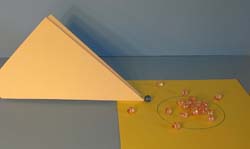Hi,
This Kids Science Newsletter includes a question of the month, current science events, science trivia and a simple science experiment.
How far and how fast do hummingbirds fly?
(answer follows the simple science experiment)
Science Current Events
- Rare Pacific Gray Whale Heads South
- A rare Pacific gray whale left Russian waters and is heading south. The whale, named "Flex" is being tracked by researchers. The whale traveled over deep waters in the Bering Sea as it swims south. These whales are the second most endangered species of whales. There are only 130 left. The whale was born in 1997 and was tagged on October 4, 2010. The baleen whale has traveled over 4,127 miles when this article was written.
- Warm Weather Brings Pesky Flies to New Zealand
- People living in New Zealand are being plagued with flies because of La Nina. The cooling of the tropical Pacific Ocean has brough high temperatures and unusually wet weather to the region. The flies were able to hatch and much higher numbers and earlier this year because of La Nina.
- Polar Bear has Epic Swim
- Melting ice near the North Pole has increased the summertime distances that polar bears must swim between ice floes and land where they hunt seals for food. A polar bear swam an epic journey this summer off northern Alaska. The mother bear swam 426 miles. She swam continuously for 10 days straight. She lost 22 percent of her body fat and her yearling cub did now survive the long journey.
- Temperature extremes last month
- Tarcoola, South Australia reached +118 degrees Fahrenheit on a summer day last month. Oimyakon, Siberia slipped to -64 degrees Fahrenheit.
Science Trivia
- Woodward Avenuein Detroit, Michigan, carries the designation M-1. It was given this name because it was the first paved road anywhere.
- The average American drives 627,000 miles in their lifetime. Drivers using cars powered by gasoline use approximately 3 fuel tankers full of fuel during their lifetime.
- Siberia contains more than 25% of the world's forests.
- The end of the minute hand on Big Bend in London, a famous clock, travels 118 miles each year.
- Some hummingbirds are so tiny they weight less than a penny!
- The water at Angel Falls in Venezuela drops 3,212 feet. This is the highest waterfall in the world and is 15 times higher than Niagara Falls.
- The world record for flying a paper airplane is over 200 feet.
- Clams can live for over a hundred years.
Simple Science Activity
Marble Game
Introduction
In this activity you will create a game to play with marbles using a ramp and marbles.

Materials
- File folder
- Scissors
- Scotch tape
- String
- Marbles
Directions
- Create a ramp for the marbles to roll down with a file folder.
- Fold the bottom of the file folder so it creates a V.
- Fold the sides of the file folder so it sits on the floor evenly.
- When the file folder looks like the picture tape it together.
- Cut a string so it forms a circle about 10 inches in diameter and lay it on a flat surface.
- Place marbles in the center of the circle, keeping one for each player to use as a shooter.
- Place the file folder next to the circle and the first player rolls the marble down the incline. All the marbles that roll out of the circle are the players to keep during the game.
- The file folder may be moved around the outside of the circle after each player takes a turn.
- When all the marbles have been hit out of the circle the winner is the player with the most marbles.
Answer to the question of the month
How far and how fast do hummingbirds fly?
Hummingbirds can fly up to 71 miles per hour. The longest documented migratory flight of a humingbird is a distance of 1,414 miles. The rufous humingbird flew from Ramsey Canyon, Arizona to near Mount Saint Helens Washington after it was banded.
More Fun and Interesting Web Pages
Make some Dinosaur Footprint Cookies
Build some marble powered race cars
Share the newsletter
Please feel free to share this newsletter with a friend by forwarding it to them. If you know of a group who might enjoy the newsletter please let them know about it also.
Comments? Ideas? Feedback? I'd love to hear from you. Just reply to this Just For Kids Science Newsletter and tell me what you think!
Sincerely yours,
Myrna Martin
Websites:
www.RingofFireScience.com
www.Kids-Fun-Science.com
|



